October 2008 LIP of the Month
The Kunene anorthosite Complex, its satellite intrusions, and possible links to early Kibaran intrusions in Tanzania and Burundi
(the present text has been extracted from Maier et al., 2008a,c, where more complete descriptions are given)
W.D. Maier,
Centre for Exploration Targeting, University of Western Australia, Perth, Australia
wdmaier@cyllene.uwa.edu.au
Abstract
The Kunene Complex of Namibia/Angola represents one of the largest concentrations of anorthosite on Earth measuring between 12,000 and 20,000 km2 in size. The Complex consists of a number of distinct anorthosite and leucotroctolite intrusions, analogous to other large anorthosite masses, e.g. Lac St. Jean, Nain, or Laramie. The Namibian portion of the Kunene Complex is distinctly layered and measures ca 80 x 50 km (ca. 4000 km2). The compositions of olivine (Fo 59-77) are amongst the most primitive known from anorthosite massifs anywhere. Plagioclase has An 56-70. Preliminary isotope data indicate mantle-like δ18O (5-7), δ34S (+0.4 to +3) and εNd(T) (+0.9 to +1.8). One of the “satellite” intrusions of the Complex, at Ohamaremba, contains disseminated Ni-enriched sulfides, suggesting that the Kunene Complex has potential to host magmatic sulfide deposits of the type discovered at Voisey’s Bay, Canada. The similarity in age between the Kunene Complex and the Kabanga-Musongati-Kapalagulu intrusive belt in Tanzania-Burundi could suggest a sub-continent wide igneous event in central and southern Africa, but this remains to be constrained by more age and compositional data, particularly from Angola and the Democratic Republic of the Congo.
Regional Geology of the Kunene Complex
The Kunene anorthosite Complex is located in Namibia and Angola, near the southern margin of the Congo craton (Fig. 1). It intruded Early Proterozoic to late Archean (Cahen et al., 1984; Carvalho and Alves, 1990) granite-gneiss basement rocks and Palaeo- to Mesoproterozoic supracrustal rocks of the Epupa Complex (ca. 1800-1330 Ma, SHRIMP zircon data of Seth et al., 2003). The geotectonic setting of the Kunene Complex suggests possible geotectonic analogies to other large anorthosite massifs that intruded near craton margins, e.g. the Laramie anorthosite Complex (Frost et al., 1993).
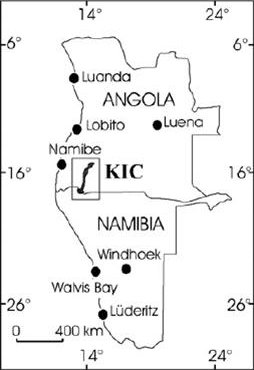

Figure 1: (a) Locality map (from Ashwal and Twist, 1994). (b) View of Zebra Mountains main massif.
An age of 1350-1370 Ma has been determined by Mayer et al. (2000, 2004) for the Angolan portion of the Complex, based on the Rb/Sr method applied to biotite-plagioclase and whole rocks (1347±13 Ma) and the U/Pb method on zircons (1371 +/-2.5 Ma) from a possibly co-genetic mangerite vein. For the Namibian portion, Drueppel et al. (2007) determined an age of 1385±25 Ma.
The Angolan portion of the Kunene Complex consists largely of massive anorthosite and leucotroctolite with numerous Fe-Ti oxide plugs (Ashwal and Twist, 1994; Morais et al. 1998), whereas the Namibian portion of the Complex contains both massive anorthosite and layered leucotroctolite-anorthosite (Köstlin, 1967, 1974, Menge, 1998). Associated with the Kunene Complex are several granitic bodies that have been dated at 1302±20 to 1411±24 (Rb-Sr whole rock ages, Basot et al., 1981; Carvalho et al., 1987; Carvalho and Alves, 1993). Based partly on the overlap in age with the Kunene Complex, they may represent crustal melts that formed in response to ponded basaltic magmas at depth.
The internal structure of the Kunene Complex remains unclear. Regional trends of cryptic variation in the Angolan portion of the Complex have caused some authors to interpret the Complex as an analogue to a large layered intrusion (Silva, 1990, 1992). Other workers (also largely working in Angola) are skeptical of this interpretation and instead suggest that the Complex represents an analogue to a composite Proterozoic massif-type anorthosite (Ashwal and Twist, 1994; Morais et al., 1998), based on the observed relatively large grain size of plagioclase (1-2 cm on average), the absence of modal/compositional layering, the lack of correlation between the composition of mafic and felsic phases, and the presence of block structures. Some of these characteristics also occur in the Namibian portion, but in other regards the latter shows features more typical of layered intrusions, most notably a distinct large- and small-scale modal and compositional layering and mineral compositions that are more primitive than in other massif-type anorthosites (as discussed below). Thus, the Namibian Kunene Complex may represent a layered composite troctolite/anorthosite body analogous to the Michikamau intrusion of Labrador (Carvalho, 1990).
In the periphery of the main anorthositic-troctolite masses in both Namibia and Angola several ultramafic-mafic bodies have been identified (Fig. 1) ranging in composition from dunite to harzburgite, pyroxenite, gabbro, troctolite and anorthosite (Stone and Brown, 1958; Vermaak, 1981; Menge 1998; Maier et al., 2008c). Some of these intrusions, notably the troctolites and anorthosites, arguably represent satellites to the main Kunene Complex. For the other intrusions, such a genetic link remains more speculative in the absence of detailed compositional and age determinations.
Lithologies
The Kunene Complex in Namibia may be broadly sub-divided into a massive body of predominantly anorthosite in the NW and a layered body of interlayered leucotroctolite and anorthosite in the SE (Fig. 2). The massive anorthosites tend to be pervasively altered to an assemblage of saussurite, actinolite, carbonate, chlorite and epidote, resulting in a whitish colour of the rock (hence, this variety of anorthosite is commonly referred to as “pale” anorthosite). The layered anorthosites contain both pale and dark anorthosites and leucotroctolites. The two phases are interlayered on a scale of dm to 10s of m, visible in outcrop (Fig. 3) and satellite photos (Fig. 2). The dark phase may form dykes and sills within the pale anorthosite (Köstlin 1967, 1974). Furthermore, the dark phase may contain dm- sized sub-angular inclusions and rheomorphic veins of pale anorthosite. Dykes of granite and syenite may inject the pale anorthosite, but not the dark leucotroctolite. These observations suggest that the pale anorthosite is older than the dark leucotroctolite.
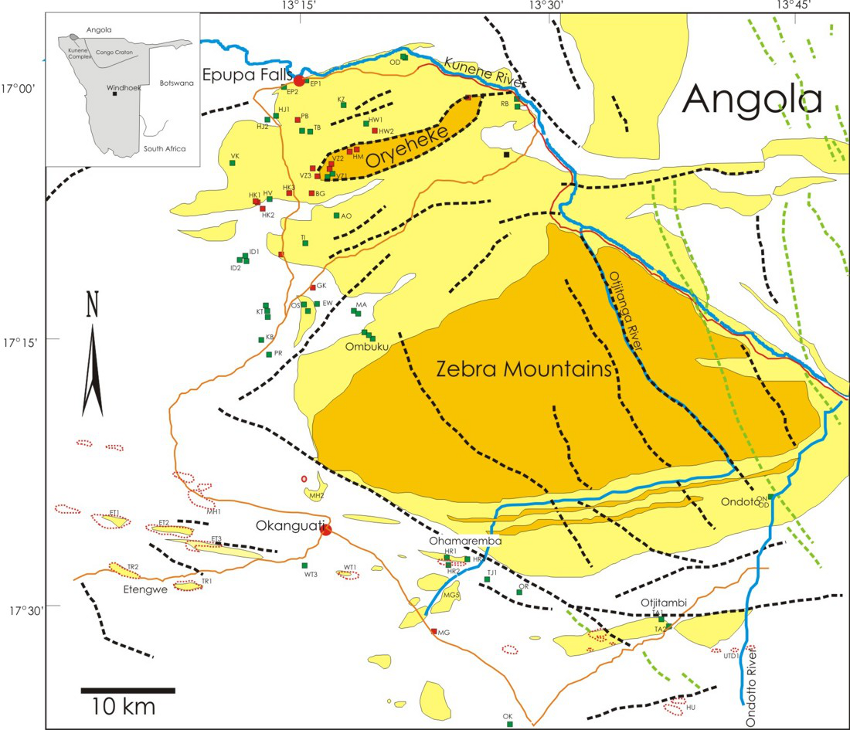
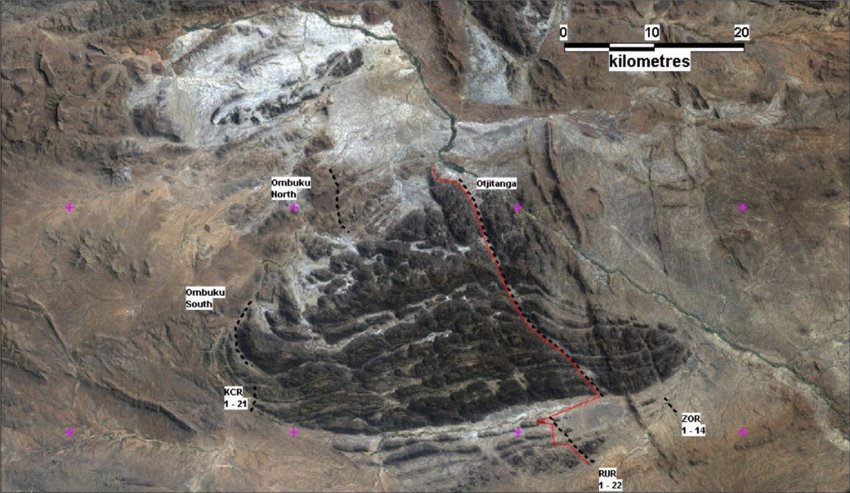

Figure 2: (a) Geological map of the Kunene Complex in Namibia (compiled after Köstlin, 1967, Menge, 1998, and unpublished company reports). (b) Landsat image showing location of sampling traverses conducted by various exploration initiatives across the Zebra Mountain lobe. Present study is largely based on the Otjitanga traverse (shown in red). (c) North-South section through the Zebra lobe, broadly along Otjitanga river traverse (figure modified after diagram by K. Kasch, unpublished company report).
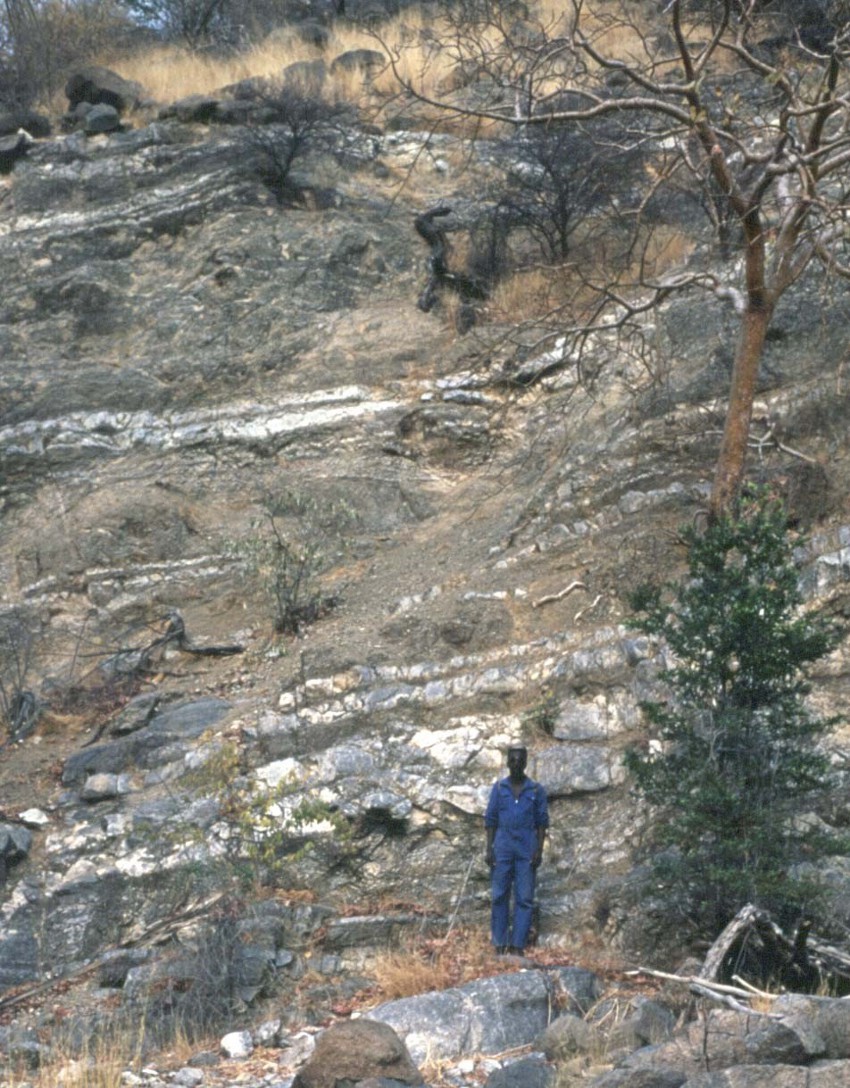
Figure 3: Outcrop of interlayered pale anorthosite and dark leucotroctolite in the Otjitanga river gorge. Note sharp contacts between layers.
Amongst the possible satellite bodies to the Kunene Complex in Namibia (Fig. 2), gabbroic rocks are probably the most common (Ombuku, the WT bodies), but troctolites (Ohamaremba), pyroxenites (Etengwe), and peridotites (Etengwe, Ombuku, Otjitambi) also occur.
Structure
An extensive set of structural measurements was taken along the Otjitanga River valley and elsewhere in the Complex by K. Kasch. The data confirm previous interpretations of Köstlin (1967, 1974) and Menge (1998) that the Complex forms a dome-like anticlinal structure, dipping to the S at relatively steep angles (40-60°) and to the North at a somewhat shallower angle (10-40°). Along the western edge of the Zebra Mountain lobe, the layers dip ca 20-40° to the west. The measurements allow the construction of a section through the Complex (Fig. 2) and a stratigraphic profile (Fig. 4). The stratigraphic thickness is approximately 16 km, comparable to other massif-type anorthosites (Ashwal, 1993) and confirming that anorthosite intrusions are relatively thick compared to many mafic-ultramafic layered intrusions which tend to have larger width to thickness ratios (e.g. Bushveld, 300-400 km diameter, 7-9 km thickness). In part, this may be due to a relatively higher viscosity of crystal-charged anorthositic-troctolitic magma.
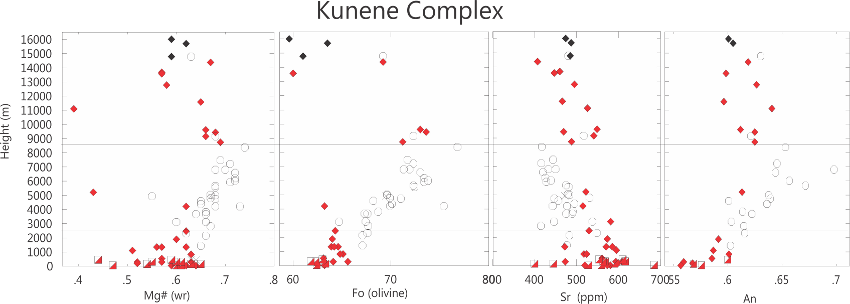
Figure 4: Whole rock compositional data plotted vs stratigraphic height in the Zebra lobe, Otjitanga River traverse.
Petrography
The majority of the analysed samples are anorthosites and leucotroctolites with between 0 and ca. 15 % olivine, most of the remainder being plagioclase. Less abundant primary phases include clinopyroxene, orthopyroxene, magnetite and sericite. Plagioclase forms tabular grains up to 3 cm in length. Many olivines are partially altered and have coronas of orthopyroxene, garnet and fibrous amphibole. These mineral assemblages were used by Drüppel et al. (2001) to deduce equilibration of the rocks at ca. 8 kbar and 790±80°C. Clinopyroxene fills interstices between plagioclase and olivine grains producing a sub-ophitic and, in rare cases, an ophitic texture. Euhedral and subhedral pyroxene is rare. No pyroxene megacrysts were found. Intercumulus orthopyroxene is much less abundant than clinopyroxene in both anorthosites and gabbros.
The rocks of the main Kunene Complex contain negligible amounts of sulfides. In contrast, the Ohamaremba troctolite body contains up to 5% disseminated sulfides (pyrrhotite with lesser amounts of granular pentlandite and chalcopyrite).
Within the dark leucotroctolites and anorthosites two groups of samples could be distinguished on the basis of texture. In Group 1, plagioclase is granoblastic and forms a polygonal mosaic with 120° grain boundaries. Rocks belonging to this group occur dominantly in the centre of the Zebra Mountain lobe. In Group 2 plagioclase shows protoclastic deformation, resulting in mortar textures and bent twin lamellae. Similar deformation textures have elsewhere been interpreted as a result of mechanical deformation in a flowing plagioclase crystal mush (Longhi and Ashwal, 1985), degassing of the magma or replenishment of the magma chamber (Ashwal, 1993).
Mineral compositional data
Contrary to the Angolan portion of the Complex (Ashwal and Twist, 1994) the olivines from the Otjitanga traverse show distinct cryptic variation across the analysed profile (Fig. 4). Grains in the deformed phase at the base of the intrusion have Fo62-65, those of the granular phase in the centre of the intrusion have Fo64-77, and those from the deformed phase at the top have Fo59-73. Notably, the Fo contents of the olivines within the central leucotroctolite are higher than those of most other massif-type anorthosites elsewhere in the world (Fig. 5), and than those of the Kunene Complex in Angola (Fo 64-70, Ashwal and Twist, 1994; Slejko et al., 2002). The Ni contents of the olivines are between 900 and 1600 ppm and broadly correlate with Fo. Their compositions are comparable to those from mafic-ultramafic layered intrusions.
The composition of plagioclase in the Otjitanga traverse plots between An56-70, with the highest values observed in the central portion of the section. There is a broad positive correlation between the compositions of plagioclase and olivine (Fig. 5). The present results differ from those of Ashwal and Twist (1994) from the Kunene Complex in Angola. These authors observed a lack of correlation between the composition of plagioclase and olivine, typical of massif-type anorthosites worldwide, and usually explained by plagioclase flotation in a staging chamber followed by ascent and emplacement of a crystal mush enriched in plagioclase phenocrysts (Ashwal, 1993).
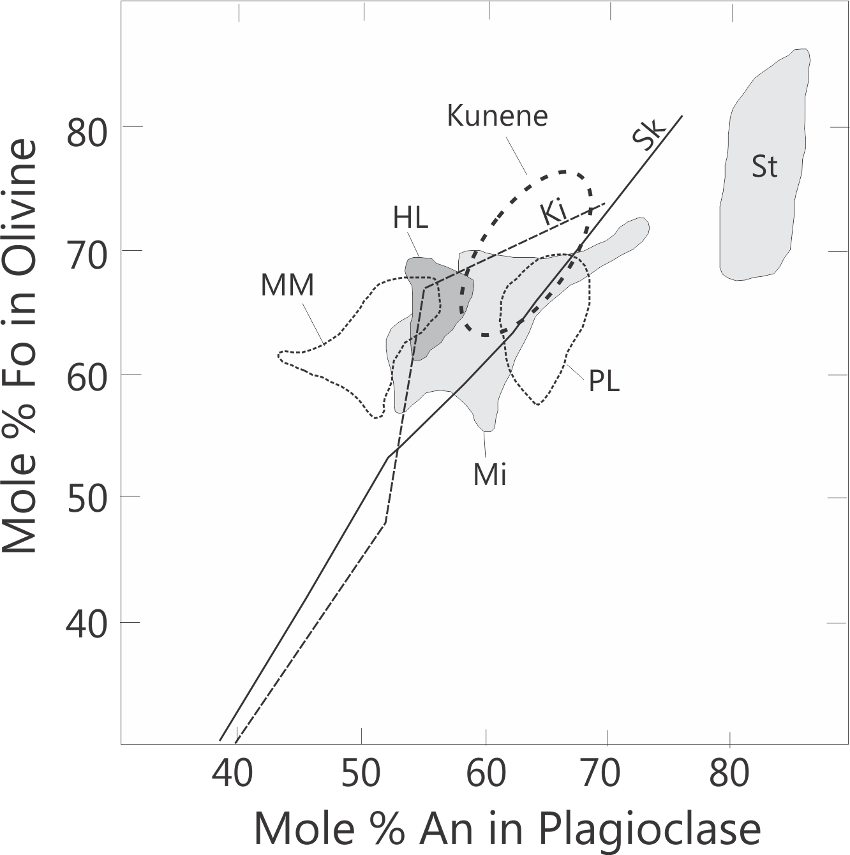
Figure 5: Comparison of Fo contents of olivine with An content of plagioclase from massif-type anorthosites and selected layered intrusions. Note that compositions of Zebra Mountain samples are more magnesian and calcic than anorthosites elsewhere. Figure modified after Ashwal (1993).
Whole rock chemistry
The leucotroctolites and anorthosites from the Otjitanga traverse contain up to 8 % MgO. The compositional range of the present samples extends towards higher MgO contents than that of the samples from Angola (Morais et al. 1998). Selected data from the Otjitanga traverse are plotted vs stratigraphic height in Fig. 4. Modal variations in the profile may be broadly estimated using Sr contents of the rocks (Fig. 4). The central granular portion of the intrusion constitutes its most mafic segment, whereas the under- and overlying portions are more feldspathic. The rocks show a progressive increase in whole rock Mg# from the base to ca. 8700 m height. The remainder of the sequence has somewhat lower Mg# (as well as Cr and Ni) contents than the central portion, but is not as differentiated as the basal portion of the intrusion.
The highly incompatible trace elements show mostly very low concentrations (< 5 ppm combined Zr, Y and Nb in most samples). This confirms the petrographic observations indicating that the rocks are essentially adcumulates. The southernmost samples near the margin of the intrusion contain markedly higher Zr, Y and Nb contents suggesting localized contamination.
The Kunene anorthosites are relatively poor in PGE (mostly < 10 ppb Pt and Pd) suggesting that the magmas equilibrated with small amounts of sulfides prior to emplacement, an event that evidently failed to extract significant amounts of Ni and Cu from the magma.
The isotopic composition of some rocks in the Zebra lobe has been reported by Drueppel et al. (2007). Initial results for the Otjitanga traverse are broadly consistent with their results. Oxygen isotopes from 5 samples indicate δ18O of 5.3-7.3 ‰, in the range of the mantle. Sulfur isotopic results are inconclusive. Anorthosite in the Oryeheke structure has δ34S 0.5-1 ‰, some of the satellites including Ohamaremba and Ombuku have δ34S 0.4-3 ‰, and amphibolite and quartzite of the basement rocks have δ34S 1.3-4.8 ‰. Five samples have been analysed for Nd isotopes (by B. Eglington, University of Saskatchewan at Saskatoon). They have εNd +0.9 to +1.8 (at 1370 Ma). This indicates a very minor crustal component, in contrast to the two samples analysed by Slejko et al. (2002) in Angola which show a distinct crustal signature at εNd, -5.7 to -6.4 (Fig.6). The lower crustal component in the Namibian relative to the Angolan portion of the Complex is in agreement with the more primitive compositions of the leucotroctolites in the former.
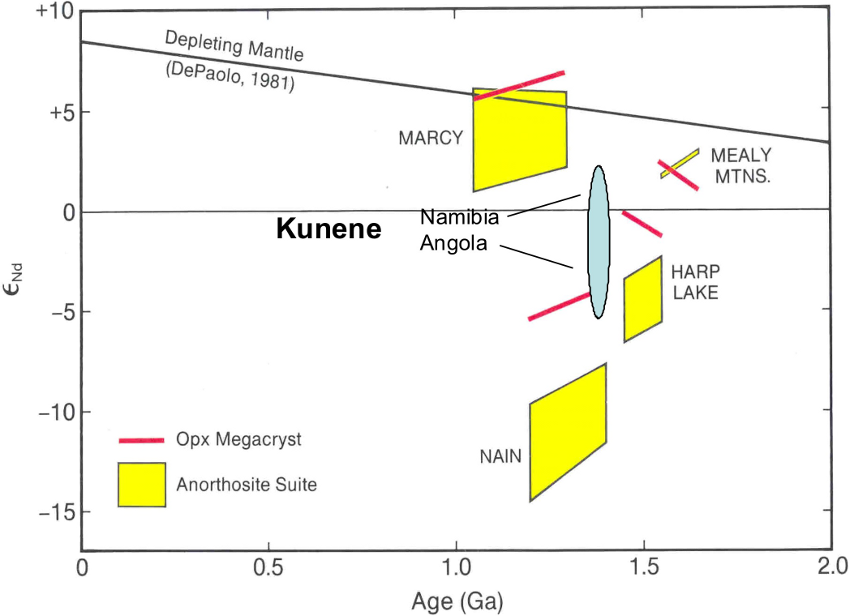
Figure 6: Nd isotope data from anorthosite massifs (Fig. provided by L. Ashwal). Kunene Nd isotope data are from Mayer et al. (2004, Angolan portion of Complex) and present study.
Origin of anorthosite magmatism
The supercotectic abundance of plagioclase in anorthosite intrusions and the apparent absence of complimentary volumes of mafic material implies that the parental magmas to the massifs contained significant amounts of plagioclase phenocrysts. This has been explained by two contrasting models:
(i) Fractional crystallization of mantle-derived magma near the crust-mantle boundary, possibly accompanied by assimilation of lower crust (Dempster et al., 1999). Mafic minerals form cumulates whereas relatively light plagioclase may float in the magma to concentrate near the roof of the magma chamber. The plagioclase-charged magma may ascend diapirically into the upper crust (Duchesne, 1984; Emslie, 1985; Ashwal, 1993; Wiebe, 1992). The anorthosites are commonly associated with ferrodioritic to monzonitic rocks that are thought to have crystallized from residual liquids of either the anorthosites or their more primitive Al-basaltic parents. Quartz-monzonitic and charnockitic intrusions are believed to be the result of melting of lower crust induced by the heat flux from the basalts (Emslie et al., 1994).
(ii) Anorthosites are the product of partial melting of mafic lower crust. (Green, 1969; Simmons and Hanson, 1978; Taylor et al., 1984; Longhi et al., 1999; Duchesne et al., 1999; Selbekk et al., 2000; Bédard, 2002). The anorthosites form a suite that evolves towards both siliceous and Si undersaturated compositions. In contrast, mantle magmas fractionating at depth would evolve towards Ne-normative compositions only. Furthermore, Bédard (2001) has shown that the trace element patterns of many anorthosites have a strong crustal signature.
Mode and depth of emplacement
Analogous to many other anorthosite massifs, the Kunene Complex is a composite intrusion that consists of several sub-massifs and possibly numerous mafic-ultramafic satellite intrusions. The present study has identified at least three distinct phases of anorthosite-troctolites (pale, deformed dark, undeformed dark). Morais et al. (1998) identified at least two additional dark leucotroctolite-anorthosite phases in Angola, and thus there are at least five distinct phases in the Kunene Complex. Some anorthosite massifs elsewhere appear to have been emplaced over relatively long time spans (e.g. Lac-St. Jean, Quebec: ca 85 my, Higgins and van Breemen, 1989) and thus dating of the rocks is one of the most important tools to decipher their crystallization history. Dating of the Kunene Complex is still in its initial stages.
The mechanism of emplacement of the Kunene anorthosite Complex may be analogous to that proposed for many other dome-like anorthosite massifs (Ashwal, 1993), i.e. emplacement of mantle-derived basaltic magma near the crust-mantle boundary, fractionation of mafic minerals followed by plagioclase, floating of plagioclase in the magma, and finally diapiric uprising of a plagioclase-rich crystal mush through the crust (Longhi and Ashwal, 1985; Emslie, 1985). According to Drüppel et al. (2001) the magma could have exploited E-W fractures that formed due to updoming of the upper mantle and resulting N-S extension. Whether the diapiric rise of the magma resulted in the dome-like shape of the intrusion, or whether the latter is a result of later deformation remains unclear.
The Kunene Complex in Namibia appears to have been emplaced at a Lower Crustal level; Drüppel et al. (2001) envisaged an emplacement depth of ca. 8.5 kbar (24 km). Notably, Slejko et al. (2002) found evidence for shallower intrusion in Angola (3-6 kbar). The deeper emplacement level of the Namibian portion of the Complex would be in agreement with the more primitive compositions of the rocks, but more work is clearly required to establish whether there is a general correlation between depth of emplacement and composition of anorthosite-troctolite massifs. Notably, the Nain anorthosite suite contains relatively few mafic-ultramafic rocks, possibly because the rocks have been emplaced into a mid- to upper crustal level (ca. 6-14 km, Berg, 1977).
Source of magmas and role of crustal contamination
The leucotroctolites from the Nambian portion of the Kunene Complex are significantly more magnesian than rocks from the remainder of the Kunene Complex in Namibia and Angola. The rocks also appear to be more primitive than other leucotroctolitic portions of massif-type anorthosite complexes elsewhere (see compilation in Ashwal, 1993), and they show more pronounced modal and compositional layering. This supports the assertion of Carvalho (1990) that the Kunene Complex is an intrusion transitional between classical massif-type anorthosites and layered mafic-ultramafic intrusions. The closest analogy amongst other anorthosite massifs appears to be the Michikamau intrusion, Labrador (Emslie, 1965).
Olivines and plagioclase within the leucotroctolites and anorthosites of the Kunene Complex in Namibia have compositions that are broadly comparable to those of mantle derived mafic-ultramafic layered intrusions such as the Bushveld Complex (Eales and Cawthorn, 1996) and are too primitive to be explained by a model of magma derivation from melting of sedimentary crustal rocks. However, large degree melting of mafic crust of igneous lineage remains a possibility (e.g. Selbekk et al., 2000).
A mantle-derivation seems even more probable for some of the ultramafic intrusions in the periphery of the Kunene Complex, notably dunites and harzburgites at Ombuku and Otjitambi that have up to 33 % MgO, high MgO/Fe2O3 ratios (up to 3), Cr (up to 4500 ppm) and Ni (up to 1600 ppm) contents. Furthermore, some of these bodies contain Ni-rich sulfides (at Ohamaremba) and massive chromitites (at Ombuku). However, it remains to be established whether these intrusions are co-magmatic with the Kunene magmas.
Trace element and isotope evidence for a significant crustal component in the Kunene rocks is inconclusive. Incompatible trace element contents are mostly low and unfractionated. The Nd and O isotopic signatures are relatively homogenous and mantle-like, but Pb isotopes are more heterogenous and do indicate a crustal component. Moreover, there is evidence for isotopic heterogeneity within the Kunene Complex. Slejko et al. (2002) found values of εNd -5 to -6, Morais et al. (1997) -8, and Mayer et al. (2004) -0.1 to -3.3 in rocks from Angola, indicating a significant component of old crust in the magmas. These data indicate that the northern portion of the Kunene Complex has a more pronounced crustal component than the southern compartment, which is in agreement with the more primitive nature of the rocks in the Namibia portion.
Economic potential
Prior to the discovery of Ni sulfide ores at Voisey’s Bay, anorthosite-troctolite intrusions had been considered poor exploration targets for magmatic sulfides. In part, this perception was based on petrogenetic grounds. Due to their relatively high Al contents, anorthositic-troctolitic magmas crystallize plagioclase after olivine, and before the pyroxenes. Because plagioclase incorporates little Fe, the Fe content of the magma decreases relatively slowly. The S solubility is positively correlated with Fe2+ content of magmas (Haughton et al., 1974), and thus S saturation of anorthosite-troctolite magmas is delayed relative to basaltic magmas. As a consequence, anorthosite-troctolite magmas require more crustal contamination to reach S saturation than tholeiites. Another negative aspect with regard to magmatic sulfide potential is that anorthositic magmas are viscous and relatively cool crystal mushes. Such magmas would have less potential to assimilate country rocks than hotter, less viscous magmas. Further, any immiscible sulfide melt that might form may not segregate effectively through the viscous magma to accumulate and form an ore deposit.
The discovery of 120 mt of Ni sulfide ores at Voisey's Bay seems to have put in question these exploration models. The Voisey’s Bay intrusive system consists of a dyke-like magma conduit linking two troctolitic magma chambers (Ryan et al., 1995; Naldrett et al., 1996; Li and Naldrett, 1999). Massive and disseminated sulfides are mainly located in widened portions of the conduit (up to several 100 m in diameter) and at the exit of the conduit into the upper magma chamber. Intensive exploration in the Nain anorthosite province following the discovery at Voisey’s Bay has identified numerous other sulfide occurrences within anorthosites, pyroxenites and troctolites, but in all cases the amount of sulfides is small and/or the sulfides have low tenors. The Voisey’s Bay deposit is associated with a major crustal suture that extends down into sulfidic paragneisses. This allowed the magma to assimilate external S which led to relatively early sulfide saturation in the primitive, Ni rich troctolitic magmas. Furthermore, the Voisey’s Bay intrusion represents a particularly dynamic magmatic environment in which sulfides could be entrained and upgraded by successive batches of metal-undepleted magmas, and concentrated in flow-dynamic traps.
Based on the experience from Voisey’s Bay, one may summarize the key exploration criteria for massive Ni-Cu sulfides in the Kunene Complex as following: (i) The main targets are rocks that crystallized from relatively primitive magma (high Mg# and Ni in olivine and pyroxene, high Cr in pyroxenes). Such magmas are relatively hot and thus have more potential to assimilate the host rocks. Furthermore, as they have relatively high Ni contents any sulfides that segregate would also have high Ni tenors. (ii) Dyke-like, pipe-like, or sill-like intrusions may represent magma conduits where sulfide melt can be concentrated in hydrodynamic traps. Many sulfide deposits elsewhere occur in relatively small bodies, e.g. Kabanga North: a tubular body of up to ca. 100 m diameter, Voisey’s Bay: a dyke of 50-several 100m. (iii) Evidence from other important magmatic sulfide deposits indicates that the magmas need to assimilate external S. Interaction with carbonaceous or felsic country rocks may lower the S solubility of the magma and thereby also result in the segregation of magmatic sulfides. However, many large magmatic sulfide deposits on Earth (e.g. Noril’sk, Pechenga, Kambalda, Kabanga) show evidence for addition of external S, and thus it is uncertain whether in the absence of such a process a deposit could form that is large enough to be economic in the remote areas of northern Namibia. (iv) The potential of the Kunene Complex to host PGE reef-type deposits is probably relatively low. This is partly based on the observation that most of the analysed Kunene rocks are highly PGE depleted, potentially due to early S saturation during assimilation of lower crust. Furthermore, PGE reefs are thought to form when segregating sulfide melt equilibrates with large amounts of silicate magma (representing high R-factor conditions). Such a process might be inhibited in the relatively phenocryst-rich and viscous troctolitic-anorthositic magmas.
In view of these considerations, the mafic-ultramafic intrusions in the periphery of the main Kunene Complex represent the most interesting targets for magmatic Ni sulfides. The presence of Ni-rich sulfides has been established in the Ohamaremba intrusion, a dyke-like body with a diameter of up to several 100 m. The exposed portion of the intrusion consists essentially of medium-grained leucotroctolite and lesser amounts of fine-grained melatroctolite. Inclusions of anorthosite are common, and reach sizes of several dm near the margins of the body. Disseminated sulfides occur at various levels within the dyke, reaching up to 5 modal % in places. The sulfides contain up to 3-4 % Ni, but PGE contents are low (< 25 ppb). This suggests that the sulfides precipitated from moderately fertile magma, and raises the prospect of Voisey's Bay-type mineralization in the Kunene Complex.
Small amounts of disseminated sulfides also occur in other satellites, e.g. Ombuku. The Ombuku intrusion is a composite mafic-ultramafic body exposed in two separate bodies; Ombuku South measures ca. 1500 x 4500 m, whereas Ombuku North measures ca 500 x 900 m. Both bodies consist of gabbronorite, olivine gabbronorite, pyroxenite, poikilitic harzburgite and dunite. Small amounts of disseminated sulfides have been identified in grab samples at Ombuku North. An up to 2m massive chromitite layer, extending for at least 160 m has been identified at Ombuku South. Sulfides have also been intersected in pyroxenites along the base of the main complex at Oncocua in Angola (unpublished company reports). These appear to be of a similar type as those found near the base of many anorthosite-troctolite intrusions in the Nain province (Scoates and Mitchell, 2000). The latter have been interpreted to represent late stage sulfide segregation events from differentiated Fe-rich liquids. They are therefore generally relatively Ni (and PGE) poor.
The main mass of the Kunene Complex is probably relatively unprospective for magmatic sulfides. This is indicated by the absence of elevated Ni contents in several traverses through the Zebra lobe performed by several exploration initiatives in the 1990s (Fig. 2) and by the results of a detailed stream sediment sampling exercise through the Zebra lobe. Ni contents of the stream sediments show analogous variation as the silicate rocks, i.e. relatively high values in the centre of the Zebra lobe compared to the northern and southern marginal areas. This suggests that (i) the stream sediments are reliable indicators of the Ni contents of the silicate rocks, (ii) the silicate rocks are uniformly undepleted in Ni, and (iii) there is little potential for Ni-rich intrusions in the centre of the Zebra lobe.
Possible links to other early Kibaran magmatic events
The ca 1.4 Ga Kabanga-Musongati-Kapalagulu mafic-ultramafic belt extends for > 500 km from Uganda to Lake Tanganyika (Deblond, 1994, Deblond and Tack, 1999, Duchesne et al. 2004; Maier et al., 2007, 2008a, Figs. 1, 7). The intrusions include layered bodies of several km thickness and tens of km2 in surface and sub-surface outcrop, and numerous sills and tube-like bodies of smaller size. Dyke-like bodies appear to be relatively rare. The intrusions are hosted by metasedimentary rocks belonging to the Burundi and Karagwe Ankolean supergroups (Cahen et al., 1984). The sedimentary rocks unconformably overlie the Archean to Early Proterozoic basement of the Congo and Tanzania cratons that consists largely of granitic, granodioritic and tonalitic gneiss and migmatite (Cahen et al., 1984).
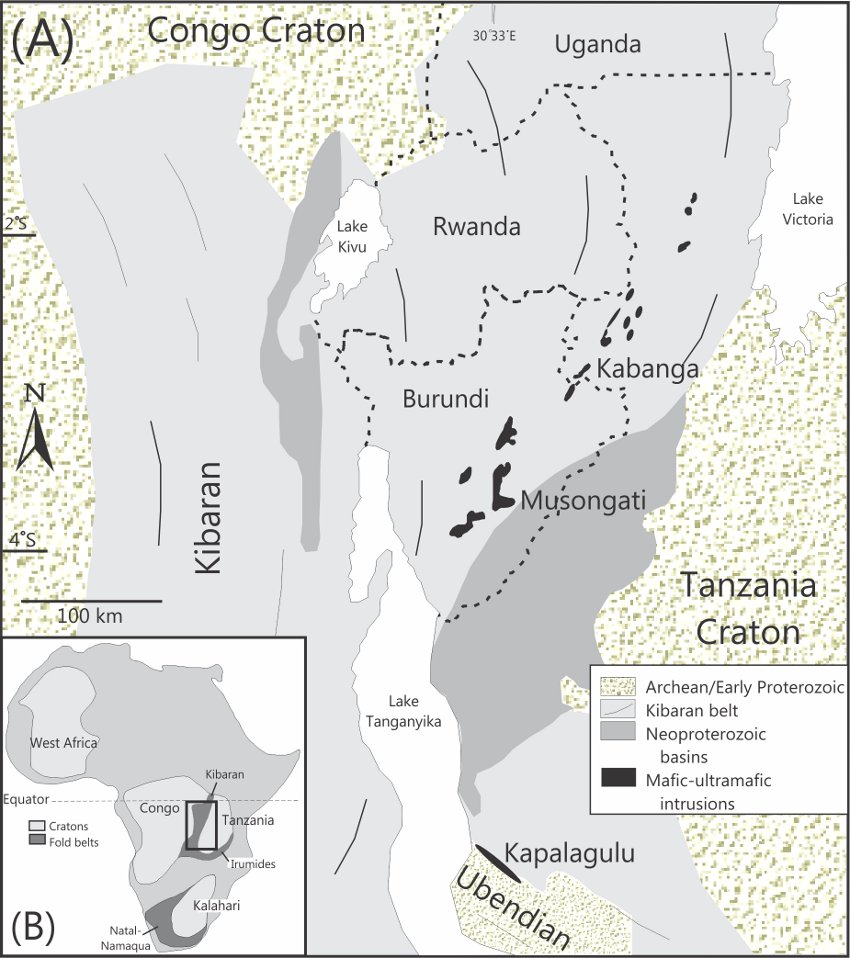
Figure 7: Locality map for Kabanga-Musongati-Kapalagulu belt of intrusions (from Maier et al., 2008a).
The sedimentary sequence is composed of up to 5000 m of alternating pelitic and arenaceous rocks deposited in shallow basins (Tack et al., 2002). The combined age- and geologic constraints suggest that the sedimentary rocks were deposited during an early rifting phase of the Kibaran basin (Pohl, 1994). The sedimentary rocks have been deformed during the Kibaran orogeny that extends for more than 1500 km from Uganda to the Democratic Republic of Congo and possibly into Angola and northern Namibia, where the Kunene anorthosite has been dated at 1385±25 Ma (Drüppel et al., 2007). The northeastern Kibaran belt formed as a result of collision of the Tanzanian craton and the Bangweulu Block with the Congo craton. The beginning of orogenic activity has been defined by S-type synorogenic anatectic granites emplaced at ca. 1381±8Ma (Kokonyagi et al., 2005; Tack et al., 2002).
An ophiolitic origin of the mafic-ultramafic intrusions has been considered by Kampunzu et al. (1986), Chorowicz et al. (1988) and Rumvegeri (1991), but is rejected by most authors in view of distinct contact aureoles associated with some of the bodies that indicate an intrusive nature (e.g. Tack et al., 1994).
Most early workers favoured a model whereby the sedimentary rocks accumulated in an intracontinental extensional basin, possibly in a fluvial and shallow marine environment with euxinic sulfidic and graphitic sediments deposited in locally restricted basins (Grey, 1967; Klerkx et al., 1987). The Kabanga magmatism and associated Ni deposits could then be explained by a mantle plume intersecting a continental rift and contamination of the magma by the rift sediments. This model is consistent with the apparent overlap between the ages of the intrusions and their sedimentary hostrocks, the crystallization sequence of the intrusive rocks (ol-opx-plag-cpx) suggesting derivation from a siliceous high-Mg basalt, and the genetic models applied to the formation of other large Ni deposits e.g. at Pechenga, Noril’sk or Raglan (Barnes and Lightfoot, 2006, and references therein). The continental margin setting within an orogenic belt would be the result of later plate tectonic processes. The relatively unmetamorphosed nature of the rocks, i.e. the lack of an orogenic signature, would have to be explained by strain partitioning.
Kokonyagi et al. (2005) suggested that there is an apparent lack of matching lithologies on the eastern margin of the Congo craton and the western margin of the Tanzania craton that would be expected in case of rifting. They favour magma emplacement in a regionally compressive, continental arc environment with the magmas being derived from a metasomatised mantle wedge above a subduction zone. A magma source in the sub-continental lithospheric mantle was also suggested by e.g. Deblond (1994); Tack et al. (1994; 2002) and Duchesne et al. (2005). There are numerous examples of sulfide mineralization associated with mafic magmatism in continental and oceanic arc and back arc environments, notably the St Stephen, Moxie, and other mafic-ultramafic intrusions in the Appalachians of North America (Paktunc, 1989), the Giant Mascot intrusion of BC (Aho, 1956), the Riwaka intrusion of NZ (Smits et al., 2004), the Aguablanca intrusion of Spain (Ortega et al., 2004), the Vammala belt of Finland (Peltonen, 2003), the Rana intrusion of Norway (Barnes, 1987), and the Phoenix and Selkirk deposits of Botswana (Maier et al., 2008b). Many of these deposits occur in distinct belts, e.g in Finland, Norway, and the eastern USA-Canada. A further possible example for mantle-derived intrusions in a highly deformed collisional setting is the Thompson belt, Manitoba. Bleeker (1990) suggested that the Thompson belt formed in a foredeep environment, and that the magmatism would be related to a combination of flux melting of a mantle wedge and the opening of pathways in response to block faulting on the flexed submerging continental margin. A late syn- or post orogenic emplacement model would also be consistent with the lack of any metamorphic overprint of the bodies.
From the above, it is clear that an improved understanding of the geotectonic setting will depend on the generation of a much more comprehensive database of high precision age dates that can establish the timing of magmatism relative to metamorphism and orogenesis.
Potential links with ca. 1380-1370 Ma Large Igneous Province (LIP) magmatism on other cratons
On the basis of paleomagnetic data, the Columbia (or Hudsonland) supercontinent consisted of Laurentia, Baltica, Uk raine, Amazonia and Australia, possibly also Siberia, North China and Kalahari (Pesonen et al., 2003). Columbia existed from ca 1.83 Ga to ca 1.5 – 1.25 Ga. The timing of breakup is often related to the 1.52-1.38 rapakivi-anorthosite magmas (Rogers and Santosh, 2002), well documented in Laurentia, SW Baltica and Amazonia. Rifting also occurred along the northern margins of the Zimbabwe-Kalahari craton, as indicated by the ca 1.4 Ga Chewore ophiolite (Rogers and Santosh, 2002). The present data suggest that the Kunene and Kabanga-Musongati-Kapalagulu LIP may also be related to Colombia breakup. During breakup the Tanzania craton first rifted away from the Zimbabwe craton and then collided with the Congo craton to cause the Kibaran orogeny.
Coeval (ca. 1380 Ma) LIP-style magmatism is also present in other parts of the world: northern Siberia, eastern East European craton, northeastern and western Laurentia, Antarctica, Kalahari craton (Ernst et al., 2008). However, given uncertainty in paleocontinental reconstructions, it is unclear whether any of these additional regions of ca. 1380 Ma magmatism are linked with the Kunene and related magmatism discussed above.
Similarities and dissimilarities with classic LIPs
Bryan and Ernst (2008) proposed some revised criteria (updated from key papers by Coffin and Eldholm 1994, 2005) for identifying a LIP: Large volume or areal extent (>100,000 cu km or sq km), short duration or short duration pulses, and intraplate setting or characteristics. In terms of areal extent, the Kunene-Kabanga-Musongati-Kapalagulu magmatism would probably not satisfy the definition of a LIP, but it is possible that it represents the deeply eroded remnants or plumbing system of a LIP, as suggested by the high-P mineral assemblages documented by Drueppel et al., (2007). Potentially also significant is the fact that associated with the KMK belt are flood basalts (the Ruiza basalts, ca 100 km NE of Kabanga) that may be coeval (Evans et al., 2000). The duration of the Kunene-KMK event remains unclear, due to the paucity of available age data. However, data from the Lac St Jean, Nain and Laramie anorthosite provinces appears to suggest that anorthosite magmatism was long lasting, perhaps occurring over > 100 ma (e.g. Higgins and van Breemen, 1992; Ryan et al., 2008). This suggests that anorthosites in general may represent longer lasting events than classical LIPs.
Acknowledgements
We thank AMBASE for permission to publish results of the Namibian exploration programmes, and Xstrata and Barrick for permission to publish the Kabanga work. Richard Ernst is thanked for thoughtful comments to the final draft.
References
Aho, A.E. (1956). Geology and genesis of ultrabasic nickel-copper-pyrrhotite deposits at the Pacific Nickel property, Southwestern British Columbia. Economic Geology 51: 444-481.
Ashwal, L.D. (1993) Anorthosites. Heidelberg, Springer, 442 pp.
Ashwal L.D. Twist, D. (1994) The Kunene complex, Angola/Namibia: a composite masif-type anorthosite complex. Geological Magazine 131: 579-591.
Ashwal, L.D., Wiebe, R.A., Wooden, J.L., Whitehouse, M.J., Snyder, D. (1992) Pre-Elsonian mafic magmatism in the Nain igneous complex, Labrador: the Bridges layered intrusion. Precambrian Research 56: 73-87.
Barnes, S.-J., (1987). Unusual nickel and copper to noble metal ratios from the Rana layered intrusion, northern Norway. Norsk. Geol. Tydskrif. 67: 215-231.
Barnes, S.-J., Lightfoot, P., (2005). The formation of magmatic nickel-copper-PGE sulfide deposits. Economic Geology, 100th Anniversary Vol., 179-213.
Bassot, J.P., Pascal, M., Vialette, Y. (1981) Donnees nouvelles sur la stratigraphie, le geochemie et al geochronologie des formations precambriennes de la partie meridionale du Haut Plateau angolais. Bull Bur Res Geol Min, Sec 4, Geol Gen 4, 285-309.
Bédard, J.H. (2001) Parental magmas of the Nain Plutonic Suite anorthoites and mafic cumulates : a trace element modelling approach. Contributions to Mineralogy and Petrology 141: 747-771.
Berg, J.H. (1977) Regional geobarometry in the contact aureoles of the anorthositic Nain Complex, Labrador. Journal of Petrology 18: 399-430.
Bleeker, W. (1990). Evolution of the Thompson Ni belt and its Ni deposits, Manitoba, Canada. PhD thesis, Univ New Brunswick, Fredericton, New Brunswick, 400 p.
Bryan, S.E., Ernst, R.E. (2008). Revised Definition of Large Igneous Provinces (LIPs). Earth-Science Reviews 86: 175-202.
Cahen, L., Snelling, N.J. (1966) The geochronology of equatorial Africa. Elsevier, Amsterdam.
Cahen, L., Snelling, N.J., Delhal, J., Vail, J.R. (1984) The geochronology and evolution of Africa. London: Oxford, 512 pp.
Carvalho, H. de, Alves, P. (1990) Gabbro - anorthosite complex of SW Angola / NW Namibia. Institutu de Investigacao Cientifica Tropical, Serie Ciencias da Terra Communicacoes, 2, Dept. Ciencias da Terra, Lisboa, 66 pp.
Carvalho, H. de, Alves P. (1993). The Precambrian of SW Angola and NW Namibia. Inst. Inv. Cientifica Tropical, Serie de Ciencias da Terra, Communicacoes 4 : 1-38.
Carvalho, H de, Crasto, J., Silva, Z.C., Vialette, Y. (1987). The Kibaran cycle in Angola : a discussion. In: Bowden, P, Kinnaird J, (Eds). African Geology Reviews. J Geol. 22: 85-102.
Coffin, M.F., Eldholm, O. (1994). Large igneous provinces: crustal structure, dimensions, and external consequences. Reviews of Geophysics 32: 1-36.
Coffin, M.F., Eldholm, O. (2005). Large igneous provinces. In: Encyclopedia of Geology. Edited by R.C. Selley, L.R.M. Cocks, and I.R. Plimer. Elsevier, Oxford, pp. 315-323.
Deblond, A. (1994). Geologie et petrologie des Massifs basiques et ultrabasiques de la ceinture Kabanga-Musongati au Burundi. Musée Royal de L’Afrique Centrale, Annales, Sciences Geologiques 99, 123 pp.
Deblond, A., Tack, L. (1999) Main characteristics and review of mineral resources of the Kabanga-Musongati mafic-ultramafic alignment in Burundi. Journal of African Earth Sciences 29: 313-328.
Dempster, T.J., Preston, R.J., Bell, B.R. (1999) The origin of Proterozoic massif-type anorthosites: evidence from interactions between crustal xenoliths and basaltic magma. Journal of the Geological Society of London 156: 41-46.
Drüppel, K., Seckendorff, V., Okrusch, M. (2001) Subsolidus reaction textures in the anorthositic rocks of the southern part of the Kunene intrusive complex, NW Namibia. European Journal of Mineralogy 13: 289-309.
Drueppel, K., Littmann, S., Romer, R.L., Okrusch, M. (2007). Petrology and isotope geochemistry of the Mesoproterozoic anorthosite and related rocks of the Kunene intrusive Complex, NW Namibia. Precambrian Research 156: 1-31.
Duchesne, J.-C., Liegeois, J.-P., Deblond, A., Tack, L. (2004). Petrogenesis of the Kabanga-Musongati layered mafic-ultramafic intrusions in Burundi (Kibaran Belt): geochemical, Sr-Nd isotopic constraints and Cr-Ni behaviour. Journal of African Earth Sciences 39: 133-145.
Duchesne, J.C. (1984) Massif anorthosites: another partisan review. In Brown WL (ed) Feldspars and feldspathoids. D Reidel Publishing Company, 411-433.
Duchesne, J.C., Liegeois, J.P., Vander Auwera, J., Longhi, J. (1999) The crustal tongue melting model and the origin of massive anorthosites. Terra Nova 11: 100-105.
Eales, H.V., Cawthorn, R.G., (1996). The Bushveld Complex, in Cawthorn, RG (ed) Layered intrusions, Elsevier, Amsterdam, 181-229.
Emslie, R.F. (1965) The Michikamau anorthositic intrusion, Labrador. Canadian Journal of Earth Sciences 2: 385-399.
Emslie, R.F. (1985) Proterozoic anorthosite massifs. In Tobi A, Touret JLR (eds), The deep Proterozoic crust in the North Atlantic provinces. NATO ASI Ser C, 158, Reidel, Dordrecht, 39-60.
Emslie, R.F., Hamilton, M.A., Theriault, R.J. (1994) Petrogenesis of a Mid-Proterozoic anorthosite-mangerite-charnockite-granite (AMCG) complex: isotopic and chemical evidence from the Nain Plutonic Suite. Journal of Petrology 102: 539-558
Ernst, R.E., Wingate, M.T.D., Buchan, K.L., Li, Z.X. (2008). Global Record of Large Igneous Provinces (LIPs) during evolution of the Rodinia supercontinent (1600-700 Ma). Precambrian Research 160: 159-178.
Evans, D.M., Byemelwa, L., Gilligan, J. (1999). Variability of magmatic sulphide compositions at the Kabanga nickel prospect, Tanzania. Journal of African Earth Sciences 29: 329-351.
Evans, D.M., Boadi, I., Byemelwa, L., Gilligan, J., Kabete, J., Marcet, P. (2000). Kabanga matic Ni sulfide deposits, Tanzania: morphology and geochemistry of associated intrusions. Journal of African Earth Sciences 30: 651-674.
Frost, B.R., Frost, C.D., Lindsley, D.H., Scoates, J.S., Mitchell, J.N. (1993) Tha Laramie anorthosite Complex and Sherman batholith: geology, evolution, and theories of origin. In: Snoke, A.W., Steidtmann, J.R., Roberts, S.M. (eds), Geology of Wyoming. Geol Surv Wyoming, Memoir 5, 119-161.
Green, T.H. (1969) High-pressure experimental studies on the origin of anorthosite. Canadian Journal of Earth Sciences 6: 427-440.
Higgins, M.D., van Breemen, O. (1999) Age of the Lac-St-Jean anorthosite intrusion and associated mafic rocks. Geol Assoc Can – Min Assoc Can, Progr Abstr 14: A84.
Haughton, D.R., Roeder, P.L., Skinner, B.J. (1974). The solubility of sulfur in mafic magmas. Economic Geology 69: 451-462.
Kampunzu, A.B., Rumvegeri, B.T., Kapenda, D., Lubala, R.T., Caron, J.P. (1986). Les kibarides d’Afrique centrale et orientale: une chaine de collision. Geology for economic development, Newsletter/Bulletin 5, 125-137.
Klerkx, J., Liegeois, J.P., Lavreau, J., Claessen, W., (1987). Crustal evolution of northern Kibaran belt in eastern and central Africa. In Kroner A (ed), Proterozoic crustal evolution, Amer Geophys Union, Geodynamics series 17, 217-233.
Köstlin, E.C. (1967) The geology of part of the Kunene Complex, Kaokoland, South West Africa. MSWc thesis, unpubl., Univ Cape Town.
Köstlin, E.C. (1974) The Kunene basic complex, northern South West Africa. In Kroner A (ed) Contributions to the Precambrian Geology of Southern Africa, Univ Cape Town, Dept. of Geology, Bulletin 15: 123-135.
Kokonyangi, J., Kampunzu, A.B., Pouyol, M., Okudaira, T., Yoshida, M., Shabeer, K.P. (2005). Petrology and geochronology of Mesoproterozoic mafic-intermediate plutonic rocks from Mitwaba (D.R. Congo): implications for the evolution of the Kibaran belt in central Africa. Geological Magazine 109-130.
Li, C., Naldrett, A.J. (1999) Geology and petrology of the Voisey’s Bay intrusion: reaction of olivine with sulphide and silicate liquids. Lithos 47: 1-31.
Longhi, J., Ashwal, L.D. (1985) Two-stage models for lunar and terrestrial anorthosites: petrogenesis without a magma ocean. Proc Lunar Planet Sci Cond 15th, Part 2. Journal of Geophysical Research 90, (Suppl): pp C571-C584.
Longhi, J., Vander Auwera, J., Fram, M.S., Duchesne, J.-C. (1999) Some phase equilibrium constraints on the origin of Proterozoic (massif) anorthosites and related rocks. Journal of Petrology 40: 339-362.
Maier, W.D., Peltonen, P., Livesey, T. (2007) The ages of the Kabanga North and Kapalagulu intrusions, western Tanzania: a reconnaissance study. Economic Geology 102: 147-154.
Maier, W.D., Barnes, S.-J., Bandyayera, D., Livesey, T., Li, C., Ripley, E. (2008a) Early Kibaran rift-related mafic-ultramafic magmatism in western Tanzania and Burundi: petrogenesis and ore potential of the Kapalagulu and Musongati layered intrusions. Lithos 101: 24-53
Maier, W.D., Barnes, S.-J., Chinyepi, G., Barton, J.M., Eglington, B., Setshedi, I. (2008b). The composition of magmatic Ni-Cu-(PGE) sulfide deposits in the Tati and Selebi Phikwe belts of eastern Botswana. Mineral Deposita 43: 37-60.
Maier, W.D., Teigler, B., Miller, R. (2008c) The Kunene anorthosite complex and its satellite intrusions. In R.Mc.G. Miller, (ed.), The Geology of Namibia, Geol. Survey of Namibia, 9-1 to 9-18
Mayer, A., Sinigoi, S., Miguel, L.G., Morais, E., Petrini, R.. (2000) Kibaran ages in the Kunene anorthositic complex. GEOLUANDA 2000, Abstract volume, p. 106.
Mayer, A., Hofmann, A.W., Sinigoi, S., Morais, E. (2004). Mesoproterozoic Sm-Nd and U-Pb ages for the Kunene Anorthosite Complex of SW Angola. Precambrian Research, 133, 187-206.
Menge, G.F.W. (1998) The antiformal structure and general aspects of the Kunene Complex, Namibia. Z Dt Geol Ges 149: 431-448.
Morais, E., Sinigoi, S., Mayer, A., Mucana, A., Miguel, L.G., Neto, J. (1998) The Kunene gabbro-anorthosite complex: preliminary results based on new field and chemical data. Africa Geoscience Review 5, 14.
Naldrett, A.J., Keats, H., Sparkes, K., Moore, R. (1996) Geology of the Voisey’s Bay Ni-Cu-Co deposit, Labrador, Canada. Exploration and Mining Geology 5: 169-179.
Ortega, L., Lunar, R., Garcia-Palomero, F., Moreno, T., Martin-Estevez, J.R., Prichard, H.M., Fisher, P. (2004). The Aguablanca Ni-Cu-PGE deposit, southwestern Iberia: magmatic ore-forming processes and retrograde evolution. Canadian Mineralogist 42: 325-350.
Pactunc, A.D. (1989). Petrology of the St Steven intrusion and the genesis of related nickel-copper sulfide deposits. Economic Geology 84: 817-840.
Peltonen, P. (2003). Svecofennian mafic-ultramafic intrusions. In: Lehtinen M, Nurmi PA, Ramo OT (eds)., The Precambrian bedrock of Finland – key to the evolution of the Fennoscandian Shield. Elsevier Sciences, Amsterdam, 411-446.
Pesonen, et al., (2003) Paleomagnetic configuration of continents during the Proterozoic. Tectonophysics, 375: 289-324
Pohl, W. (1994), Metallogeny of the northeastern Kibara belt, Central Africa – recent perspectives. Ore Geology Reviews 9: 105-130.
Rogers, J.J.W., Santosh, M. (2002) Configuration of Colombia, a Mesoproterozoic Supercontinent. Gondwana Research 5: 5-22.
Rumvegeri, B.T. (1991). Tectonic significance of Kibaran structures in central and eastern Africa. J. Afr. Earth Sci. 13: 267-176.
Ryan, et al. (2008) Anorthosite types and settings, northeastern Labrador: same space, different times. GacMac 2008, Quebec City, Abstract, p. 150.
Ryan, B., Wardle, R.J., Gower, C.F., Nunn, G.A.G. (1995) Nickel-Copper sulphide mineralization in Labrador: The Voisey’s Bay discovery and its exploration implications. In Current Research Report 95-1, Geol Surv, Dept. Nat Res, Gov of Newfoundland and Labrador, 177-204.
Scoates, J.S., Mitchell, J.N. (2000) The evolution of troctolitic and high-Al basaltic magmas in Proterozoic anorthosite plutonic suites and implications for the Voisey's Bay massive Ni-Cu sulfide deposit. Economic Geology 95: 677-701.
Selbekk, R.S., Skjerlie, K.P., Pedersen, R.B. (2000) Generation of anorthositic magma by H2O-fluxed anatexis of silica-undersaturated gabbro: an example from the north Norwegian Caledonides. Geol. Mag. 137: 609-621.
Seth, B., Armstrong, R.A., Brandt, S., Villa, I.M., Kramers, J.D. (2003) Mesoproterozoic U-Pb and Pb-Pb ages of granulites in NM Namibia: reconstructing a complete orogenic cycle. Precambrian Research 126: 147-168.
Silva, Z.C.G. (1990) Geochemistry of the gabbro-anorthosite complex of Angola. J. Afr. Earth Sci. 10: 683-692.
Silva, Z.C.G. (1992) Mineralogy and cryptic layering of the Kunene anorthosite complex of SW Angola and Namibia. Min. Mag. 56: 319-327.
Simmons, E.C., Hanson, G.N. (1978) Geochemistry and origin of massif-type anorthosites. Contrib. Mineral. Petrol. 66: 119-135.
Simpson, E.S.W. (1970) The anorthosite of southern Angola: a review of present data. In African magmatism and tectonics. Edinburgh, Oliver & Boyd.
Slejko, F.F., Demarchi, G., Morais, E. (2002) Minera chemistry and Nd isotopic composition of two anorthositic rocks from the Kunene complex (South Western Angola). J. Afr. Earth Sci. 35: 77-88.
Smits, R., Beresford, S., Schaefer, B. (2004). Emplacement of a dyke-hosted NiS deposit, Nelson, New Zealand. Abstr., 17th Austr. Geol. Conv., Hobart, Tasmania, p. 122.
Stone, P., Brown, G.M. (1958) The Quinita-Cunene layered gabbroic intrusion of south-west Angola. Geol. Mag. 95: 195-206.
Tack, L., Liegeois, J.-P., Deblond, A., Duchesne, J.C. (1994). Kibaran A-type granitoids and mafic rocks generated by two mantle sources in late orogenic setting (Burundi). Prec. Res. 68: 323-356.
Tack, L., Fernandez-Alonso, M., Tahon, A., Wingate, M. (2002). Meso and Neoproterozoic emplacement ages of magmatic rocks in Burundi: new constraints for the geodynamic evolution of the Northeastern Kibaran belt (NKB). Abstract Vol IGCP 418/440 (the Kibaran of southwest Africa) technical meeting, Windhoek, 2002.
Taylor, S.R., Campbell, I.H., McCulloch, M.T., McLennan, S.M. (1984) A lower crustal origin for massif-type anorthosites. Nature 311: 372-374.
Vermaak, C.F. (1981) Kunene anorthosite Complex. In Hunter, D.R. (ed) Precambrian of the southern hemisphere, Amsterdam, Elsevier, 882 pp.
Wiebe, R.A. (1992) Proterozoic anorthosite complexes. In: Condie, K.C. (ed) Proterozoic crustal evolution. Amsterdam: Elsevier, 215-261.
